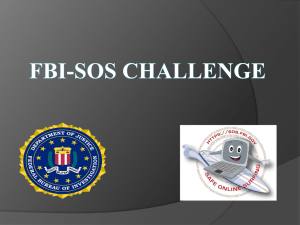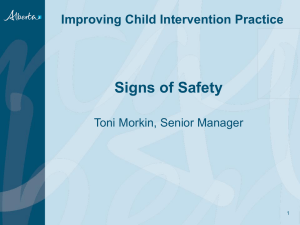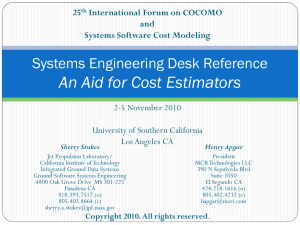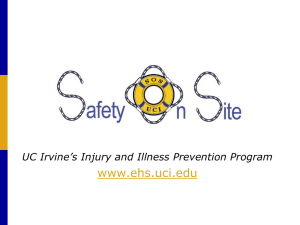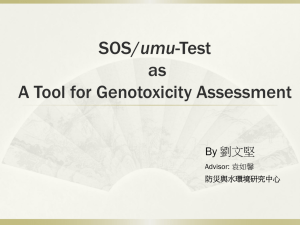A Model of Systems Engineering in a System of Systems Context
advertisement
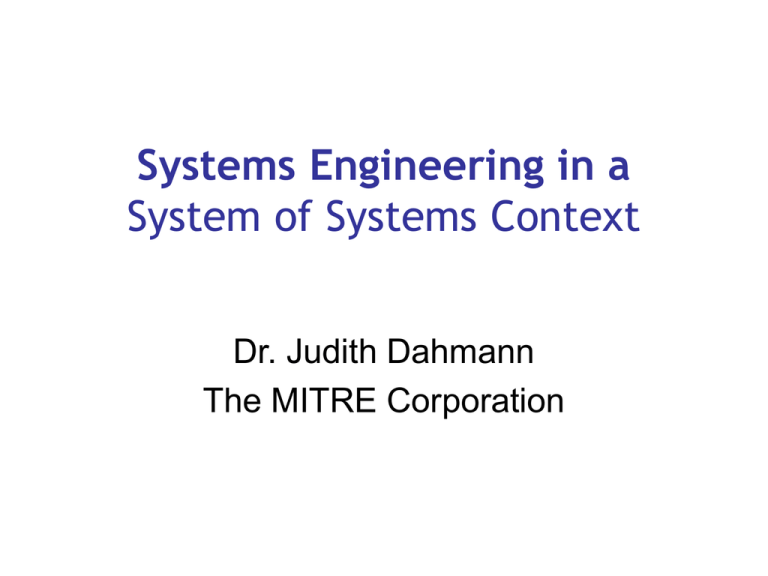
Systems Engineering in a System of Systems Context Dr. Judith Dahmann The MITRE Corporation Introduction • Systems engineers are increasingly called upon to – Implement SE in networked environments – Evolve existing and new systems to meet changing user needs • Challenge is to leverage SE processes developed and applied for SE of new systems – Individual systems are no longer considered as individual bounded entities and are evolved based on extant capabilities – Constituents in larger, more variable, ensembles of interdependent systems which interact based on end-to-end business processes and networked information exchange • A new set of conditions for their SE processes calls for a new SE framework that reflects the – Dynamics and uncertainty of SoS – Added complexity of operating in an SoS environment 2 DoD System of Systems SE Guide SoS Guide Version 1.0 • Effort led by the Office of the Secretary of Defense • Collaborative approach with DoD, Industry, Academia • Purpose – 6 month effort addressing areas of agreement across the community – Focus on technical aspects of SE applicable across SoS management constructs – Vehicle to capture and debate current SoS experience • Audience – SoS and Program Managers and Lead/Chief Engineers Pilot • Pilot effort ‘Boots on the Ground’ basis for – Structured reviews with practitioners – Refine early draft guide content, identify areas for future study – Update findings and release Version 1.0 3 Definitions System: A functionally, physically, and/or behaviorally related group of regularly interacting or interdependent elements; that group of elements forming a unified whole. (JP 1-02 & JP 3-0) SoS: A set or arrangement of systems that results when independent and useful systems are integrated into a larger system that delivers unique capabilities [DoD Defense Acquisition Guide, 2004]. Taxonomy of SoS – Directed • SoS objectives, management, funding and authority; systems are subordinated to SoS – Acknowledged • SoS objectives, management, funding and authority; however systems retain their own management, funding and authority in parallel with the SoS – Collaborative • No objectives, management, authority, responsibility, or funding at the SoS level; Systems voluntarily work together to address shared or common interest – Virtual • Like collaborative, but systems don’t know about each other 4 Active SoS SE Practitioners Name Army Battle Command System Air Operations Center Ballistic Missile Defense System USCG Command & Control Convergence Common Aviation Command & Control System Distributed Common Ground Station DoD Intelligence Information System Future Combat Systems Ground Combat Systems Military Satellite Communications Naval Integrated Fire Control – Counter Air National Security Agency Naval Surface Warfare Center Dahlgren Single Integrated Air Picture Space and Missile Systems Center Space Radar Theater Joint Tactical Networks Theater Medical Information Systems – Joint Acronym ABCS AOC BMDS C2 Convergence CAC2S DCGS-AF DoDIIS FCS GCS MILSATCOM NIFC-CA NSA NSWC SIAP SMC SR TJTN TMIP Owner Army Air Force Joint Coast Guard Marine Corps Air Force Intel Army Army Joint Navy Intel Navy Joint Air Force Joint Joint Joint Approach Acquisition Program Acquisition Program Acquisition Program Strategy Acquisition Program Program Office DIA CIO Initiative Program Office Program Executive Office PEO AF Wing SE Integrator in PEO Agency Warfare Center Acquisition Program SE Authority Acquisition Program PEO Acquisition Program Provided a basis for understanding SoS in DoD Today 5 Focus on Acknowledged SoS • Increased US DoD emphasis on war fighter capabilities – Typically require multiple systems to meet end-to-end capability needs – Approach has been to leverage current systems to meet new capability needs • However, current systems are still needed for original use – And since most systems are developed and managed by the Military Services, responsibility for systems often differs from responsibility for capabilities or SoS – Consequently, there are increasing instances of acknowledged SoS in the US DoD • Characterized by dual management, funding and technical authorities – Source of management issues which impact SE • V1 of the guide provides an initial resource for SE teams working in this environment Acknowledged SoS growing in the US DoD They have received little attention to date 6 SE Model for SoS Based on 7 Core Elements of SoS SE Translating Translating capability Translating capability objectives capability objectives objectives Assessing Assessing (actual) Assessing (actual) performance performance performance totocapability to capability capability objectives objectives objectives Orchestrating Orchestrating Orchestrating upgrades upgrades upgrades to toSoS SoS Understanding Understanding systems Understanding systems&& relationships relationships systems & (includes (includesplans) plans) relationships to SoS Addressing Addressing new Addressing new requirements requirements requirements & & solution &options options Developing, Developing, Developing evolving and evolving and maintaining & evolving SoSmaintaining design/arch SoS SoS design/arch options Monitoring Monitoring Monitoring & assessing &changes assessing & assessing changes architecture New SoS SE role Persistent SoS overlay framework SoS upgrade process External influences changes External Environment 7 SE Processes Support Core Elements • DoD Defense Acquisition Guide presents 16 basic SE processes • In an SoS, SE team adapts these processes to execute core SE elements • Focus for SoS SE is on technical management since implementation is in systems SoS SE Core Elements Translating Translatingcapability Capability objectives Objectives Understandingsystems Systems Understanding relationships &&Relationships Assessing performance Assessing Performance to To capability objectives Capability Objectives Developing&&evolving Evolving Developing an SoS Architecture SoS architecture Monitoring&and Assessing Monitoring assessing Changes changes Address requirements Requirements & Addressing Solution Options and solution options Orchestrating Orchestratingupgrades Upgrades to SoS Technical Processes Rqts Devel Logical Design Implement Integrate Verify Analysis Solution Technical Management Processes Validate Transition Decision Tech Tech Config Interface Rqts Mgt Risk Mgt Data Mgt Analysis Planning Assess Mgt Mgt X X X X X X X X X X X X X X X X X X X X X X X X X X X X X X X X X X X X X X X X X X X X X X X X X X X 8 Core Elements of SoS SE (1 of 3) Translating Translating capability Translating capability objectives objectives capability objectives Understanding Understanding systems & Understanding systems & relationships relationships (includes plans) (includes plans) systems & relationships Monitoring & Monitoring assessing &changes assessing changes Monitoring & assessing changes • Translating SoS capability objectives into high level requirements over time • SoS objectives based on broad capability objectives • SE team plays strong role in establishing requirements and understanding dynamics of the environment • Identifying and understanding the systems that impact SoS objectives • Focus on components and dynamics vs boundaries • Extends beyond technical to broader context of management, organizational, development plans, funding, etc. • Anticipating and assessing impacts of potential changes on SoS performance • Given scope of SoS authority, key to SoS SE is identifying and addressing changes in systems and other areas (e.g. threat) which may impact the SoS 9 Core Elements of SoS SE (2 of 3) • Developing and evolving SoS architecture Developing, Developing, Developing evolving evolvingand and maintaining & evolving maintaining SoS SoS SoSdesign/arch design/arch architecture • This includes • Concept of operations • Systems, functions and relationships and dependencies, both internal and external • End-to-end functionality, data flow and communications within the SoS. • Provides the technical framework for assessing options and implications for meeting requirements over time • Persistence, tolerance for change • An architecture is the structure of components, their relationships, and the principles and guidelines governing their design evolution over time (IEEE Std 610.12 and DoDAF). • The architecture of an SoS is a persistent technical framework for governing the evolution of an SoS over time. 10 Core Elements of SoS SE Addressing requirements & solution options Addressing new Addressing new requirements requirements & options & options Orchestrating Orchestrating Orchestrating upgrades upgrades upgrades to SoS to toSoS SoS Assessing Assessing (actual) (actual) performance toperformance capability to capability objectives objectives Assessing performance to capability objectives (3 of 3) • SoS requirements and solution options • Requirements addressed at both SoS & systems • Recommend SoS requirements based on both priority and practicality • SoS and system SE teams identify and assess options • Result is plan for development for next increment • Orchestrating SoS Upgrades • Upgrades implements by systems under system SE teams • SoS SE team plans, facilitates, integrates and tests upgrades to the SoS • Development based on approaches (bus stop, wave) which accommodate asynchronous system developments • Assessing SoS Performance • Based on measures of SoS user results applied in different settings (test, exercises, M&S, operations) • Opportunity to identify changes and emergent behavior 11 View of SoS Upgrade Assessing performance to capability objectives For each increment Recommend Id for this rqts increment Addressing requirements & solution options Addressing Addressingnew new Identify requirements candidate requirements &&options systems to options support functions Assess options Negotiate with systems Develop plan (1 of 2) Assess SoS capabilities and limitations Orchestrating Orchestrating Orchestrating Validate sets upgrades upgrades of systems upgrades to SoS to SoS to SoS Verify sets of systems SoS Integrate sets of systems Coordinate, monitor and facilitate systems’ development, test and evaluation Systems 12 View of SoS Upgrade Translating Capability Objectives Monitoring & Assessing Changes Understanding Systems & relationships (2 of 2) Developing & Evolving SoS Architecture Assessing SoS Performance Addressing Addressing new Addressing new requirements requirements requirements & & solution &options options Orchestrating Orchestrating Orchestrating upgrades upgrades upgrades to toSoS SoS to SoS SoS options Systems Multiple, possibly concurrent increments 13 In Conclusion Translating Translating capability Translating capability objectives capability objectives objectives Assessing Assessing (actual) Assessing (actual) performance performance performance totocapability to capability capability objectives objectives objectives Orchestrating Orchestrating Orchestrating upgrades upgrades upgrades to toSoS SoS Understanding Understanding systems Understanding systems&& relationships relationships systems & (includes (includesplans) plans) relationships to SoS Addressing Addressing new Addressing new requirements requirements requirements & options && solution options Developing, Developing, Developing evolving and evolving and maintaining & evolving maintaining SoS design/arch SoS SoS design/arch architecture • ‘Acknowledged’ SoS, challenge the practice of SE • Research supporting the DoD SoS SE Guide have identified seven core elements of SoS SE and their relations options Monitoring Monitoring &Monitoring assessing assessing &&changes assessing changes changes External Environment 14

